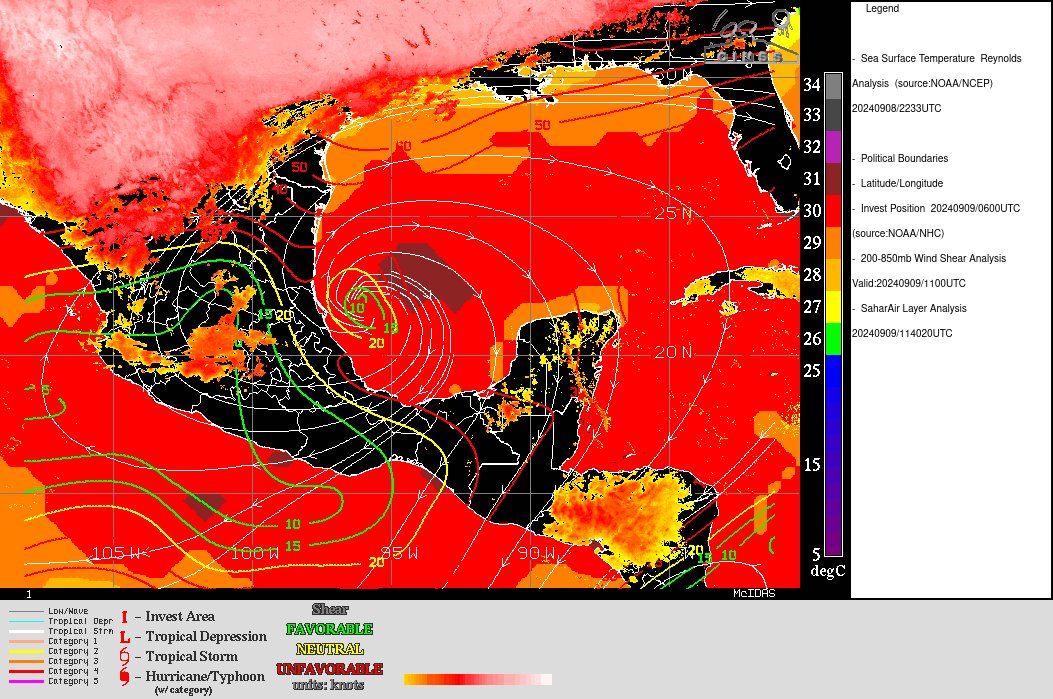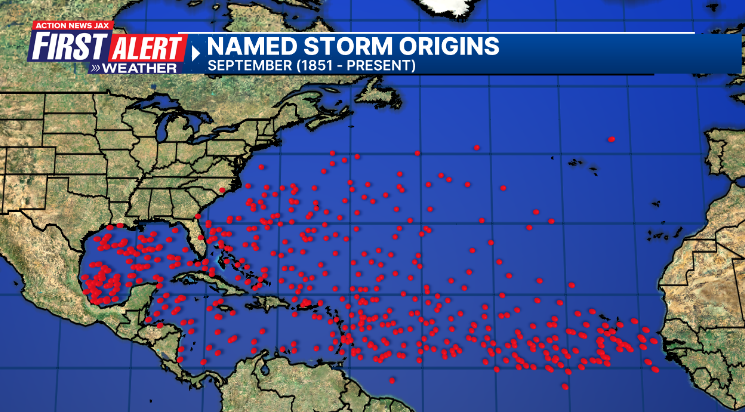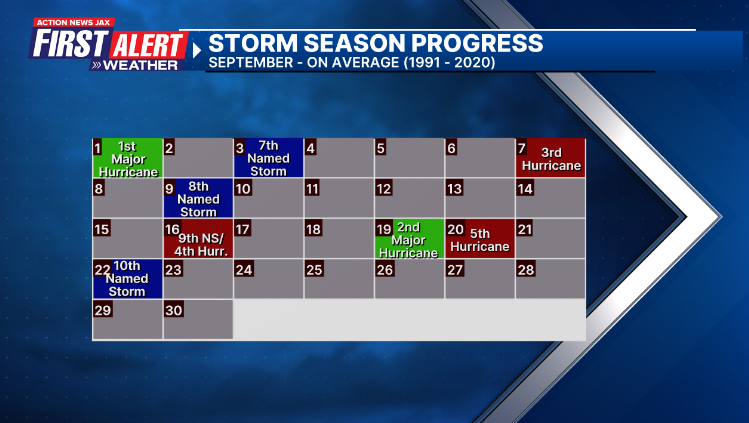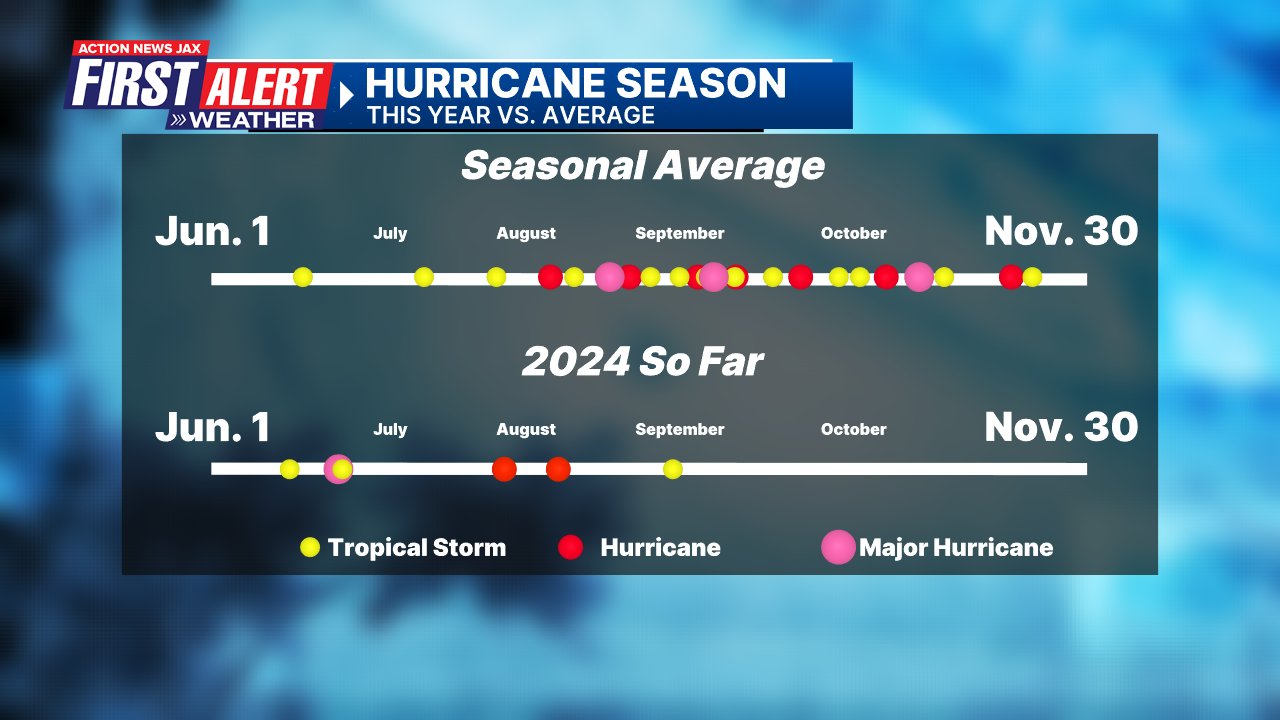Jacksonville, Fl. — The “Buresh Bottom Line”: Always be prepared!.....First Alert Hurricane Preparation Guide... City of Jacksonville Preparedness Guide... Georgia Hurricane Guide.
STAY INFORMED: Get the * FREE * First Alert Weather app
FREE NEWS UPDATES, ALERTS: Action News Jax app for Apple | For Android
WATCH “Preparing for the Storm”
WATCH “The Ins & Outs of Hurricane Season”
READ the First Alert Hurricane Center “Preparation Guide”
***** ALWAYS CHECK & RE-CHECK THE LATEST FORECAST & UPDATES! ****
Tropics threats for Jacksonville/NE Florida/SE Georgia: No direct impacts from tropical systems *but* onshore flow will increase again this week with rough seas & surf = a high rip current risk.
“Buresh Bottom Line”:
* What will soon become “Francine” is developing over the Western Gulf of Mexico with direct impacts to Texas & especially Louisiana by midweek centered on Wed. through Thu.
* A couple of tropical waves over the Central & Eastern Atlantic may develop but look to stay far out to sea for the time being.
* Some “in-close” development will be possible over the next 1-2 weeks near or along the U.S. east coast.
The Atlantic Basin Overview:
A Storm Surge WARNING: High Island Texas to the Mouth of the Mississippi River Louisiana ... Vermilion Bay A Hurricane Warning is in effect for... The Louisiana coast from Sabine Pass eastward to Morgan City.
A Storm Surge WATCH: Mouth of the Mississippi River Louisiana to the Mississippi/Alabama Border ... Lake Maurepas ... Lake Pontchartrain
A Hurricane WATCH: The Louisiana coast from Morgan City eastward to Grand Isle
A Tropical Storm WARNING: Morgan City to Grand Isle ... High Island to Sabine Pass
A Tropical Storm WATCH: Barra del Tordo to the Mouth of the Rio Grande ... Mouth of the Rio Grande to High Island Texas ... East of Grand Isle Louisiana to Mouth of the Pearl River, including metropolitan New Orleans ... Lake Pontchartrain * Lake Maurepas
(1) ‘91-L′ - “Potential Tropical Cyclone Six” was upgraded to tropical storm “Francine” Mon. morning. Francine is a product of the Caribbean wave I’ve been tracking for the past 7+ days reached the Yucatan Peninsula Friday & moved over the Bay of Campeche over the weekend. Meanwhile... weak surface low pressure near the coast of Texas drifted southward. As hypothesized late last week, it appears these two are interacting & will develop a tropical cyclone over the far Western Gulf of Mexico. Forecast models have nicely converged on track & intensity with the European & Climavision ‘Horizon’ models joining the GFS & Canadian with a stronger system more to the east which translates into more time over water with a north/northeast movement putting the upper coastal Texas coast & especially Louisiana potentially in line for a hurricane by the middle of the week. The GFS is generally a little more east (landfall on the central coast of Louisiana... Climavision more west near the Texas/Louisiana border... & the European model roughly in-between. Personally - I favor at least a little more easterly position given a stationary front remains from the Western Gulf all the way to Florida while weak to moderate upper level troughing persists over the Central & Eastern U.S. It looks like there will be enough of a softness extending all the way to the Northern Gulf to maintain the necessary alleyway to move more north & northeast. All “systems” - lower shear, lots of humidity & warm ocean water - point to a strengthening storm once an inner core becomes established. Shear will increase along the coast at landfall but by then it may not matter a whole lot as the system should be well developed + moving with - at least somewhat - the shear vectors in addition to upper air ventilation provided by the upper level trough.
Landfall will be Wed. afternoon between Lake Charles & New Orleans approximately south & southwest of Lafayette. Folks all along the Gulf Coast - & especially from Texas to Louisiana & Mississippi - should stay up to date on the latest forecasts. . Heavy rain & flooding may extend as far north as at least Memphis, Tennessee. Hurricane hunter aircraft will start investigating the system on a regular basis.
For the Atlantic: the sixth named - ‘F’ - storm of the season avg. date is Aug. 29th... the 4th hurricane avg. date is Sept. 16th.
(2) We’re also seeing mixed signals regarding a nearly stationary boundary from the Gulf to the Western Atlantic that gets reinforced by a series of upper level troughs & possible low pressure developing at the surface along the front all the way through next week. This could be some “in-close” development anywhere from the Gulf to the far Western Atlantic. Some models indicate the potential for some tropical activity from near Florida northward across the Western Atlantic next week & beyond. Any low pressure that might develop over the Western Atlantic will move east & northeast away from the U.S. But if low pressure forms closer to Florida &/or the Bahamas then impacts would be possible for Florida & the Southeast U.S. This scenario is highly variable.
(3) Multiple tropical waves are moving west & northwest between the Caribbean & Africa - something one would expect this time of year. At least one - ‘92-L’ has longer term potential as they rather slowly move west or northwest... the slow movement due to the Bermuda high that currently is displaced to the east & northeast over the Atlantic. Such a position favors an alleyway for systems to turn north over the Central Atlantic... as long as the Bermuda High remains in such a state.
Fitting the pattern for an increase in tropical activity is persistent & seasonally strong surface high pressure at northern latitudes from the Central U.S. to the Northwest Atlantic. This high pressure will bring has brought an early taste of fall across the Northern U.S. & may induce general low pressure to the south - a pattern that *could* favor tropical development at southern latitudes. It’s Mother Nature’s constant balancing/compensating act. And it’s likely why we’ve seen forecast models struggle with the overall pattern developing sometimes spurious low pressure areas near & south of of about 35 degrees N.









The experimental Climavision ‘Horizon’ model below for late Wed., Sept. 11th shows a strong tropical cyclone just off the coast of upper Texas & SW Louisiana. The ‘horizon’ trend has been east & stronger:
From CIMSS - diagnosis of conditions in vicinity of what will be Francine - very warm water, low shear (until the Northern Gulf), plenty of moisture:
Very heavy rain for much of the Gulf coast yet again for the upcoming week:


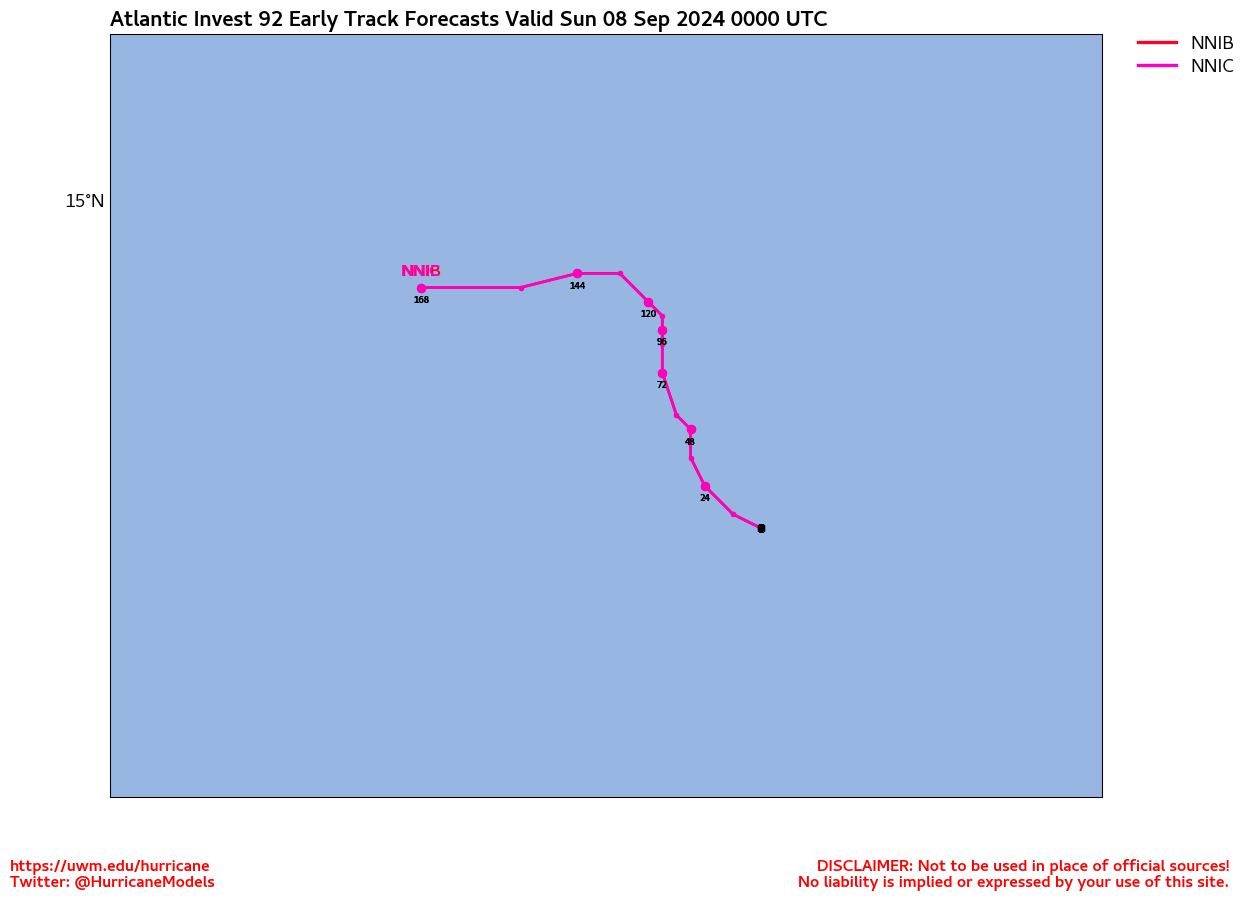

‘Velocity potential anomalies’ below shows massive “sinking” air (brown lines) & overall hostile conditions for tropical development continue across the Atlantic Basin. In such a state, tropical development can occur but overall conditions are not as conducive as when there is overall rising (green lines) air such as much of the Pacific Basin where convection is active. This “pulse” of upward motion is moving closer to the Atlantic Basin & is likely aiding the Western Gulf system & will be spreading eastward over the next couple of weeks.
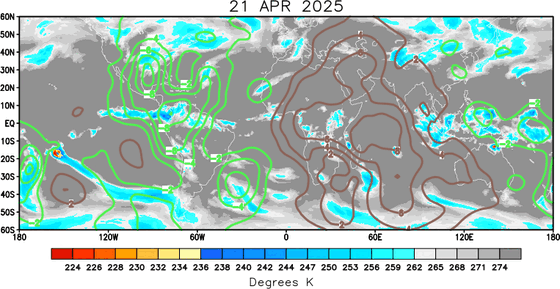
REMEMBER WHEN A TROPICAL STORM OR HURRICANE IS APPROACHING: Taping windows is *not* recommended & will not keep glass from breaking. Instead close curtains & blinds.
Realize the forecast cone (”cone of uncertainty”) is the average forecast error over a given time - out to 5 days - & *does not* indicate the width of the storm &/or where damage might occur.
The upper oceanic heat content (UOHC) [tropical cyclone heat potential/TCHP] across the SW Atlantic, Gulf & Caribbean is very high:






Water vapor loop (dark blue/yellow is dry mid & upper level air):


September tropical cyclone origins (early season breeding grounds are the Gulf &/or Western Caribbean:
Averages below based on climatology for the Atlantic Basin for September (2 hurricane so far, 3 tropical storms):
Wind shear (red - strong shear; green - low shear):



Saharan dust spreads west each year from Africa driven by the prevailing winds (from east to west over the Atlantic). Dry air = yellow/orange/red/pink. Widespread dust is indicative of dry air that *can* interfere with the development of tropical cyclones. However, sometimes “wanna’ be” waves will just wait until they get to the other side of - or away from - the dust plume then try to develop if other conditions are favorable (we’ve already seen this with Beryl & Debby this year). In my personal opinion, there is way too much “hoopla” about the presence of Saharan dust & how it relates to tropical cyclones. In any case, the peak of Saharan dust typically is in June & July.

2024 names..... “Francine” is the next name on the Atlantic list (names are picked at random by the World Meteorological Organization... repeat every 6 years). Historic storms are retired [Florence & Michael in ’18 (the last time this year’s list was used)... Dorian in ’19 & Laura, Eta & Iota in ‘20, Ida in ‘21 & Fiona & Ian in ‘22]). In fact, this year’s list of names is rather infamous because of the ‘04 season when Charley, Frances, Jeanne & Ivan - all retired names - hit Florida within a matter of about 6 weeks. The WMO decided - beginning in 2021 - that the Greek alphabet will be no longer used & instead there will be a supplemental list of names if the first list is exhausted (has only happened three times - 2005, 2020 & 2021). The naming of tropical cyclones began on a consistent basis in 1953. More on the history of naming tropical cyclones * here *.





East Atlantic:





Mid & upper level wind shear (enemy of tropical cyclones) analysis (CIMMS). The red lines indicate strong shear:
Water vapor imagery (dark blue indicates dry air):

Deep oceanic heat content over the Gulf, Caribbean & deep tropical Atlantic. The colors will brighten greatly as the water warms to greater depths deeper into the season:

Sea surface temp. anomalies:


SE U.S. surface map:

Surface analysis centered on the tropical Atlantic:

Surface analysis of the Gulf:

Caribbean:

Atlantic Basin wave period forecast for 24, 48, 72 & 96 hours respectively:





East & Central Pacific:




Hawaii satellite imagery:


West Pacific:

Global tropical activity:



Cox Media Group


